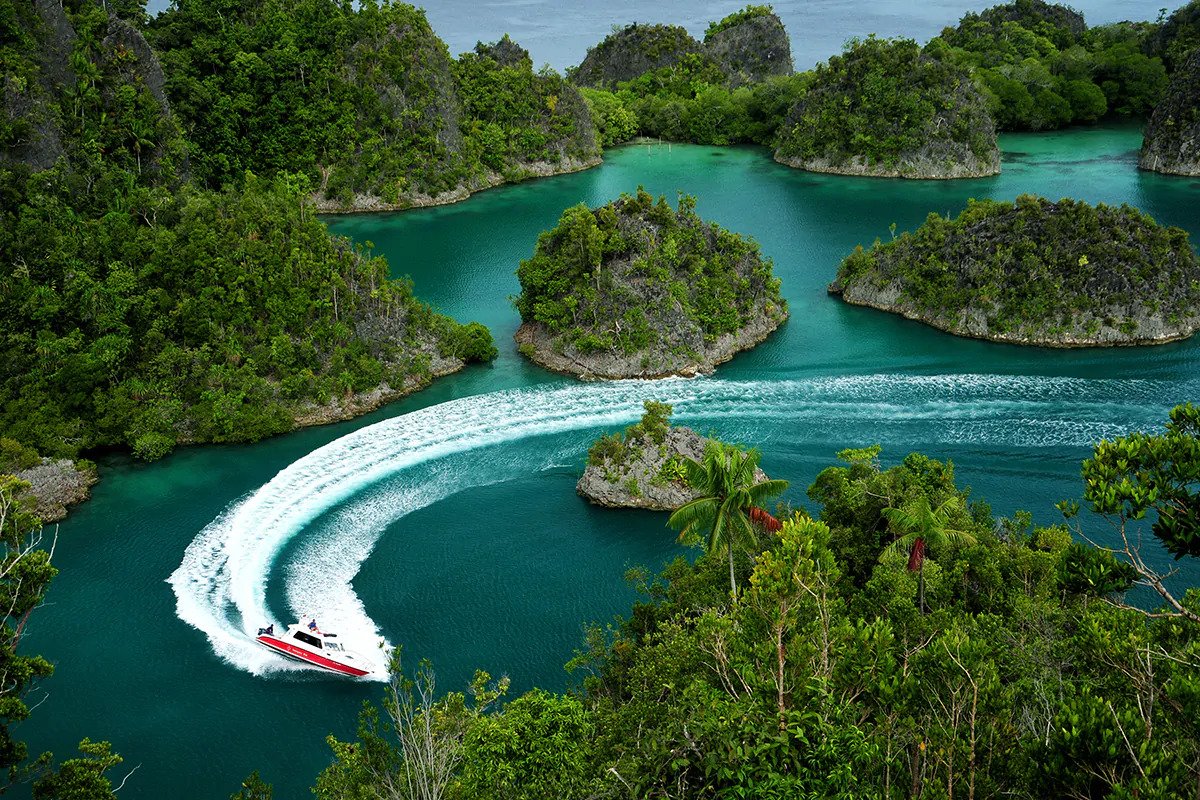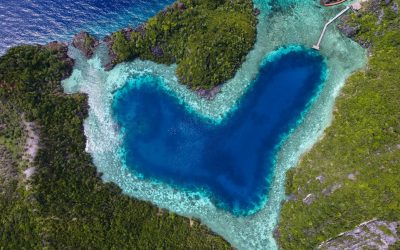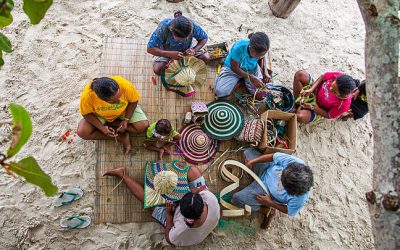Home / Batik Regions – Eastern Indonesia – West Papua / Raja Ampat National Geopark
Natural Destination
Raja Ampat National Geopark
Raja Ampat National Geopark (photo: Pesona Indonesia)
Raja Ampat National Geopark
The name of Raja Ampat refers to the Four Kings, indicating the 4 big islands in the region namely Waigeo, Misool, Batanta, and Salawati Islands. Like its name, this region is the king of all tourist destinations in West Papua. It is situated in the World’s Triangle Coral Reefs and has the most number of marine biodiversity. Due to its distinctive beauty and natural reserves, this site has been designated as Indonesian National Geopark and strategic zone for tourism. Plan your next adventure amidst the wonder of Raja Ampat!
Natural Tourism Destination
Raja Ampat National Geopark
Tourist Attractions in West Papua
Mansinam Historical Island
This holy island has been the witness of the two German catholic missionaries who introduced
Love Lagoon in Misool
This love lagoon is formed by the natural phenomenon of a mountain lake and
Arborek Village
Come and enjoy some of your time with Arborek people. Try their food and discover
West Papua
Batik Motifs
Prada Papua
The word “Prada” in the Javanese-Indonesian dialect means a batik textile that
Honai
The Honai is inspired by the traditional house of the Papuan community living in
Burung Cendrawasih
The Cendrawasih bird is believed as sacred Paradise bird that connects the earth with
Raja Ampat
Raja Ampat motif represents the marine life at Raja Ampat archipelago in
Discover
Indonesian
Batik
Motifs
Hiu Taliyasan
Indonesia is also home to the world’s largest fish, the whale shark (Rhincodon typus). Hiu Taliyasan refers to
Burung Bidadari
Bidadari birds are endemic birds in Halmahera. This motif represents an
Sekar Jati
Sekar means flower and Jati refers to teak trees that symbolizes a strong mental character that
Tanah Liek
The word “Tanah Liek” refers to clay in Minang language. It is also known as
Parang Seling
Parang Seling or “alternating daggers” is a royal batik motif. It is a feminine variant of
Karawo Mahkuta
Mahkuta refers to Gorontalo’s traditional crown. It represents noble characters of
Tikar Natuna
The Tikar Natuna motif is adapted from the traditional making of pandanus mats in
Pati-Pati Pinehiku
It symbolizes the hierarchy in society and the social status of the Mekongga
Gonggong Siput
Gonggong (Strombus Turturella) is one type of sea snail found around
Desa Na Tolu
The Desa Na Tolu characteristic pattern symbolizes the Batak philosophy of existence and
Tampuk Manggis Sasirangan
The motif illustrates the philosophy of the mangosteen fruit, which is
Biji Kopi
The coffee seeds motif illustrates the pride of local coffee specialities in
Besurek Rafflesia
The term “Basurek” refers to a textile that contains letters or inscriptions
La Galigo
La Galigo is a literary work of the Buginese Epic that has 300 thousand epic lines. It is considered even
Insang Ikan
Insang refers to the gills of the fish. This is a typical pattern of Malay ethnic who inhabits
Kuda Kupang
Horses symbolize wealth. It contains noble values of virtuous characters that bring
Pucuk Rebung Riau
Pucuk Rebung symbolizes heart determination in achieving goals, good luck, and
Taiganja
Taiganja is a precious gold pendant that shows the social status of the Kaili family. It is
Sandeq
Sandeq Boat is a symbol of the maritime importance of the West Sulawesi region. The greatness of
Leuit Sijimat
This motif reflects the daily activities of the Baduy tribe in Banten. The main ornaments of batik motif consist of:
Ukir Sentani
The Ukir motif is a batik motif that is inspired by various traditional Sentani wood carvings
Dayak Kamang
Kamang motif is generally found in the Dayak tribe shield because it is believed to
Sero Tangga
The Sero Tangga illustrates an endearing feeling and sacrifices of a person to fulfil
Malinau Cultural Festival
You will witness a unique competition that might not be found other than in
Gentala Arasy
Built as high as 80 meters, the tower also highlights the historical side of
Jumputan Bintang
The word Jumputan means the tie-dye technique, while the word “Bintang” refers to
Keluak Daun Pakis
The word “Keluak” is a Minang language which means twisted or tangled. The Motif of
Kawung
The Kawung motif was created by Sultan Agung Hanyokrokusumo (1593 – 1645) as a symbolic gift for
Buketan Bali
The Balinese bouquet (Buketan Bali) is a floral arrangement and the name is
Kerawang Tegak Aceh
The Vertical Upright (Kerawang Tegak) Motif symbolizes a person who has a strong
Kasih Tak Sampai
‘Kasih Tak Sampai’ is an idiom in the Indonesian language which refers to
Tangerang Herang
Tangerang Herang motif is a symbol of Tangerang city. The Tangerang Herang batik motif consists of
Rumah Mamuju
the Batik motif illustrates the house of Mamuju King with the stairs, located on the left of the wooden stage house
Tenun Bima
The motifs are adopted from Bima woven textile. This pattern has received a great
Gajah Way Kambas
The motif illustrates the Lampung’s natural reserve, the Way Kambas. it also symbolizes
Gurdo Solo
Gurdo or garuda bird is the mount of the Indian god Vishnu. As the Sun Bird,
Tabir Tanjung
Tanjung flower is a type of Cherry tree flower, which is commonly found in
Jupri Kembang Teh
Kembang Teh illustrates the tendrils of tea plants that grow in the highlands of
Tifa Totobuang
The batik motifs illustrate Maluku’s traditional music instrument called
Singayaksa
The Singayaksa motif comes from the name of a place where Sultan Hasanuddin used to
Bekantan Pakis
This motif represents Pakis Haji (Polystichum setiferum), an endemic plant in
Prada Papua
The word “Prada” in the Javanese-Indonesian dialect means a batik textile that
Gonggong Beruntun
This motif illustrates that a person should maintain a positive attitude and
Daun Simpor
This motif is inspired by the Simpor plant (Dillenia Suffruticosa) which is a typical
Sido Mulyo
Sidomulyo is one of the classical motifs, which is specifically used for the bride’s costume in
Daun Sirih
This motif illustrates betel leaves that are used by Lombok communities as traditional
Angsa Duo
According to legend, the Angso duo batik motif is a pair of swans that are believed to have led Princess
Sekomandi
Its philosophical meaning is the eternal union which refers to a saying “until death do us part”
Besurek Rembulan
This batik illustrates praise for God who created the wonderful universe
Pala Salawaku
This motif illustrates the unique weapons of the Maluku region, namely
Srimanganti
The name of the Srimanganti motif is derived from Palace’s hallway that connects to
Daun Lada Hitam
The black pepper motif represents the main commodity of Bangka Belitung
Dayak Taghol
Dayak Taghol has a distinctive style of four curved lines and small dots. This motif represents
Merak Ngeram
The hatching peacock motif has a very deep meaning which refers to the sacrifice and
Wirasat
Wirasat or divine inspiration is a gift from God. This inspiration is symbolized by
Raja Ampat
Raja Ampat motif represents the marine life at Raja Ampat archipelago in
Gigi Haruan Lidi
The Gigi Haruan Lidi motif is taken from the name of the cork fish and is a symbol of
Durian Pecah
Broken Durian motifs depict the foundation of faith. The second half signifies the mastery of
Mahkota Siger
Siger is the crown of a noblewoman in ancient time. It is a symbol of femininity, strength, and
Kain Cual
Cual textile tradition has existed since the 17th century. The word “Cual” refers to
Lok Baintan Floating Market
As you can imagine, the most authentic thing is that you can buy things and even
Honai
The Honai is inspired by the traditional house of the Papuan community living in
Tengkawang Ampiek
With its many advantages, the Dayaks use this leaf in ritual ceremonies. This plant is a symbol of
Pohon Hayat (Tree of Life)
The Batik motifs in Lampung are dominated by the acculturation of Buddhist and
Bintik Tujuh
The Bintik Tujuh (Seven Dots) motif has 7 white spots and green color gradation as
Enggang Dayak
Local people beliefs that hornbills are an incarnation of the Commander of the Birds. It has supernatural
Parang Rusak
Another meaning behind this motif is an unconquerable spirit, symbolized by
Bomba Mawar
This motif means sacred love for family, kingdom, and God; It also illustrates
Kaharingan
The Kaharingan or ‘tree of life’ based on the Dayak tribes’ belief system. This tree symbolizes
Gamolan
This motif illustrates Gamolan, a bamboo musical instrument of Lampung that is
Tubo Kelapa
Coconut tree is a symbol of a good character and strong mentality. It illustrates the more success a person, the more
Gorga Simeol-Meol
The Gorga Simeol-meol is a pattern of plant tendrils. it is regarded as a symbol of longevity and
Tongkonan
Toraja’s traditional house is called Tongkonan. Tongkonan is a place for
Gumin Tambun
Based on Hindu mythology, this motif symbolizes lucks, abundant wealth, and
Kaganga Tanah Rejang
If Batik Besurek combines Arabic calligraphy motifs, then the Kaganga batik takes




